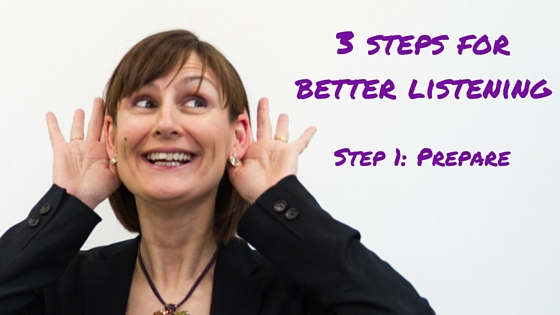Stephen Covey famously said, “Most people do not listen with the intent to understand; they listen with the intent to reply.”
I’d like to offer another observation, “Many people do not listen with the intent to understand; they listen with the intent to maintain harmony.”
Whether your listening difficulty is that you’re overeager to state your opinion or that you don’t really understand but feel you might offend if you question the other person, here are 3 steps for better listening.
1. Prepare, 2. Connect, 3. Confirm.
I’ll write about these in three posts, starting with Step 1.
Real listening is difficult. We’re not taught how to do it in school. Fortunately, some corporations offer listening skills seminars for their staff, but these are still relatively rare.
To listen well, we should prepare in two ways.
Two Ways to Prepare for Better Listening
1. Remove distractions
Have you experienced talking to a colleague, but he continues to type an email? It’s obvious that he isn’t fully listening.
As human beings, in any given moment, we can only focus on one thing that requires thought. Typing an email and listening to what someone is saying both require thought about the content, so we can’t do both at the same time.
To really listen, we need to remove distractions.
If someone wants to talk to you, either stop what you’re doing or ask them to come back at a time when you can focus.
If you want to talk about something important, schedule a time and location where you won’t be distracted.
2. Empathize
Be prepared to consider things from the other person’s perspective. What we say and do is driven by our thoughts, feelings, values, needs, and fears. These can lead to different assumptions and misunderstandings if the intention behind an action isn’t clear.
For example, a coworker who criticizes the work of his team members may seem uncooperative or mean, but perhaps his intention is for the team to produce the best quality product and this drives his action of speaking up when something isn’t of the highest standard.
We can see the action, but don’t necessarily know the intention.
Prepare yourself to listen well by taking a moment to empathize and consider the possible intention behind other people’s actions – especially with people you often disagree with!
Preparing by removing distractions and empathizing is the first step to real listening.
Next week, we’ll look at Step 2: Connect, in which I’ll introduce four ways to connect with the other person in a conversation.
If you read Japanese, have you read 英語の仕事術 yet? Read a preview of the first 16 pages and find bookstore links here.
Thank you for listening!
Thanks, TopTia, for the photo.



